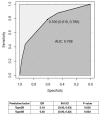ZJUSAH Classification: A New Classification for Primary Brainstem Hemorrhage
- PMID: 36984002
- PMCID: PMC10059730
- DOI: 10.3390/life13030846
ZJUSAH Classification: A New Classification for Primary Brainstem Hemorrhage
Abstract
To analyze and improve ZJUSAH classification for primary brainstem hematoma, we retrospectively reviewed 211 patients with primary brainstem hemorrhage who were admitted to our institution between January 2014 and October 2020. The primary clinical outcomes were the 30-day survival rate and 90-day consciousness recovery rate, which were evaluated using the National Institutes of Health Stroke Scale score. Univariate logistic regression and multivariate Cox regression analyses were performed to evaluate the prognostic model. The overall 30-day survival rate of the 211 patients was 69.7%. The 30-day survival rate was 95% among Type 1 patients, 77.8% among Type 2 patients, and 63.2% among Type 3 patients. The 90-day consciousness recovery rate was 63.2% among Type 1 patients, 61.9% among Type 2 patients, and 30.2% among Type 3 patients. Our findings suggest that ZJUSAH classification can be optimized according to hematoma volume, with Type 3 patients with a hematoma larger than 12.4 mL tending to have a worse state of consciousness. Additionally, we discovered that ZJUSAH classification is valuable in predicting 30-day survival rates in conservative treatment patients. In conclusion, our study established and optimized a new CT-based hematoma classification system for primary brainstem hematoma, which facilitates treatment selection and prognostic prediction.
Keywords: multiple logistic regression; predictive factors; primary brainstem hemorrhage; state of consciousness.
Conflict of interest statement
The authors declare no conflict of interest.
Figures






Similar articles
-
Prognostic models for survival and consciousness in patients with primary brainstem hemorrhage.Front Neurol. 2023 Feb 23;14:1126585. doi: 10.3389/fneur.2023.1126585. eCollection 2023. Front Neurol. 2023. PMID: 36908614 Free PMC article.
-
Effect of hematoma volume on the 30-day mortality rate of patients with primary hypertensive brainstem hemorrhage: a retrospective cohort study.Front Surg. 2023 May 5;10:1136296. doi: 10.3389/fsurg.2023.1136296. eCollection 2023. Front Surg. 2023. PMID: 37215349 Free PMC article.
-
Prognostic Significance of Magnetic Resonance Imaging in Detecting Diffuse Axonal Injuries: Analysis of Outcomes and Review of Literature.Neurol India. 2022 Nov-Dec;70(6):2371-2377. doi: 10.4103/0028-3886.364066. Neurol India. 2022. PMID: 36537418 Review.
-
How to predict the outcome of primary brainstem hemorrhage: Six-year results of a single-center retrospective analysis.Medicine (Baltimore). 2023 Sep 15;102(37):e35131. doi: 10.1097/MD.0000000000035131. Medicine (Baltimore). 2023. PMID: 37713883 Free PMC article.
-
Primary Brainstem Hemorrhage: A Review of Prognostic Factors and Surgical Management.Front Neurol. 2021 Sep 10;12:727962. doi: 10.3389/fneur.2021.727962. eCollection 2021. Front Neurol. 2021. PMID: 34566872 Free PMC article. Review.
Cited by
-
Analysis of anti-infective therapy in a challenging case of brainstem hemorrhage complicated with pneumonia.Heliyon. 2024 Dec 5;10(24):e40988. doi: 10.1016/j.heliyon.2024.e40988. eCollection 2024 Dec 30. Heliyon. 2024. PMID: 39735627 Free PMC article.
-
Vascular Diseases: Etiologic, Diagnostic, Prognostic, and Therapeutic Research.Life (Basel). 2023 May 12;13(5):1171. doi: 10.3390/life13051171. Life (Basel). 2023. PMID: 37240816 Free PMC article.
-
Development and validation of a prognostic nomogram for predicting outcomes in brainstem hemorrhage patients.Sci Rep. 2025 Jan 8;15(1):1300. doi: 10.1038/s41598-024-80264-x. Sci Rep. 2025. PMID: 39779767 Free PMC article.
References
-
- Shrestha B.K., Ma L., Lan Z., Li H., You C. Surgical management of spontaneous hypertensive brainstem hemorrhage. Interdiscip. Neurosurg. 2015;2:145–148. doi: 10.1016/j.inat.2015.06.005. - DOI
-
- Chen L., Chen T., Mao G., Chen B., Li M., Zhang H., Xi H., She X., Tang Z., Zhang P., et al. Clinical neurorestorative therapeutic guideline for brainstem hemorrhage (2020 China version) J. Neurorestoratol. 2020;8:232–240. doi: 10.26599/JNR.2020.9040024. - DOI
-
- Morgenstern L.B., Hemphill J., Anderson C.S., Becker K., Tamargo R.J. Guidelines for the Management of Spontaneous Intracerebral Hemorrhage A Guideline for Healthcare Professionals from the American Heart Association/American Stroke Association. Stroke. 2010;41:2108–2129. doi: 10.1161/STR.0b013e3181ec611b. - DOI - PMC - PubMed
-
- Steiner T., Salman R.A.S., Beer R., Christensen H., Cordonnier C., Csiba L., Forsting M., Harnof S., Klijn C.J., Krieger D., et al. European Stroke Organisation (ESO) guidelines for the management of spontaneous intracerebral hemorrhage. Int. J. Stroke Off. J. Int. Stroke Soc. 2015;9:840–855. doi: 10.1111/ijs.12309. - DOI - PubMed
Grants and funding
LinkOut - more resources
Full Text Sources

